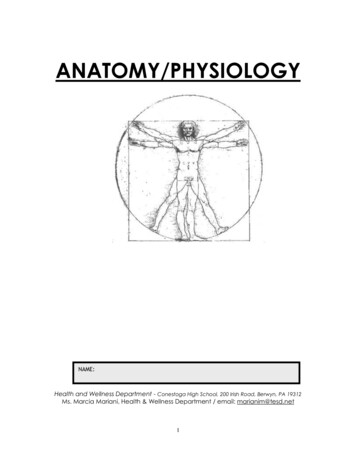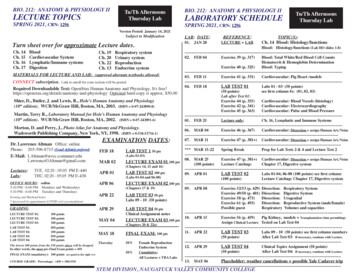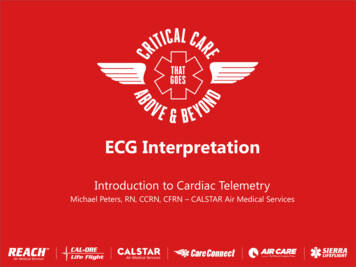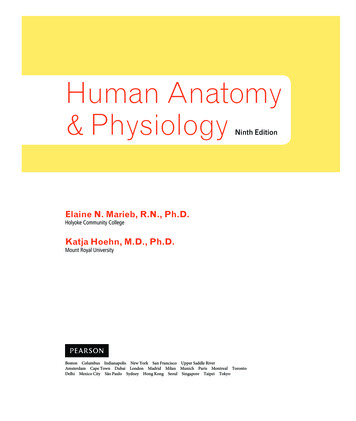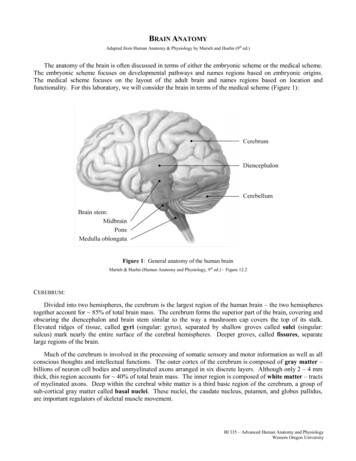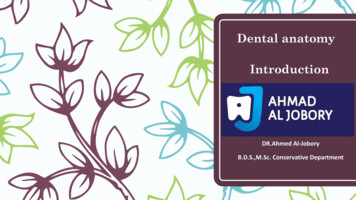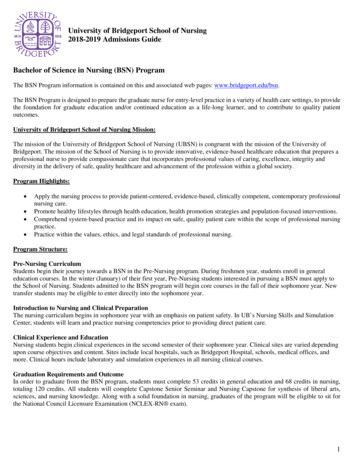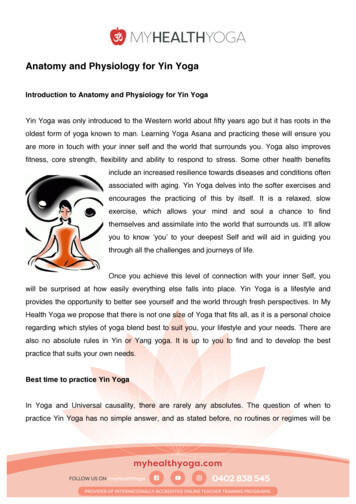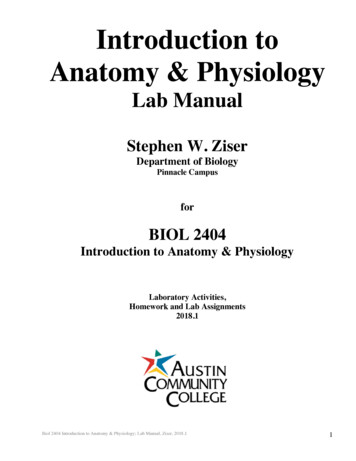
Transcription
Introduction toAnatomy & PhysiologyLab ManualStephen W. ZiserDepartment of BiologyPinnacle CampusforBIOL 2404Introduction to Anatomy & PhysiologyLaboratory Activities,Homework and Lab Assignments2018.1Biol 2404 Introduction to Anatomy & Physiology; Lab Manual, Ziser, 2018.11
Biol 2404 Lab ManualTable of ContentsI. General Laboratory Orientation .3II. Lab Safety .5.111517.III. Laboratory Activities & Homework Assignments1. Units of Measurement & Metric System Homework .2. The Language of Anatomy . . . . . . .3. Organ Systems Overview . . . . . . . .4. Experiment: Identification of Organic Molecules . . . . . 185. Microscopy . . . . . . . . . . . . . . . 236. The Cell & Cell Division . . . . . . . . . . . . 247. Human Tissues & Tissue Identification .8. Dissection of the Fetal Pig. . . . .9. Body Membranes . . . . .26303510. The Integumentary System . . .11. The Skeletal System . . . . .12. Articulations and Body Movements .36384113. The Muscular System14. The Nervous System .15. Sense Organs. .43454916. The Endocrine System .17. The Circulatory System .18. The Lymphatic System .52545719. Experiment: Hematology, Heart Sounds & Blood Pressure .20. The Respiratory System . . . . . . . .21. Experiment: Measuring Vital Capacity . . . . . .59646622.23.24.25.Experiment: Enzyme ActivityThe Digestive System . .Experiment: pH and Buffers .The Urinary System . . .26. The Reproductive System . .27. A Survey of Human Development.Biol 2404 Introduction to Anatomy & Physiology; Lab Manual, Ziser, 2018.1.69737582.83852
Biol 2404 Lab OrientationThe laboratory portion of this course is designed to study anatomical details of each body system morethoroughly than it is presented in lecture. While human models are also used, your core learning willcome from your dissections and tissue studies. If you have a real moral objection to animal dissectionsthen you should not take this course at ACC since you would not be able to learn some of the essentiallab skills and would therefore be missing an essential part of the course. This method of ‘hands on’learning should also enhance and strengthen the knowledge you gain in lectures.At times you will be working individually, in pairs or in groups of three or four. Each lab period isloosely structured to begin with a short introduction to the exercise that highlights the activities of theday, what materials are available for use and any changes in procedures. After that you will workindependently to learn the material.There is never enough time in lab to go over each and every item that you are assigned. The lab is adesignated a time when you have access to materials that you will not have available during home studytime. Some of the information assigned in lab you can learn at home, other items, particularlyanatomical terms identified on dissected organs, animals and models and microscopic details viewedwith a microscope can only be learned adequately in the lab room.General Lab Rules:1. Read the lab exercise before you come to lab. There is not time to review every aspect of eachexercise and still give you time to work on your own. I will assume that you know what the exercisecovers in general and I will only review changes or specific materials that you will use.2. Before each lab, use the terminology list to mark the items in your manual’s text and illustrationsthat you are responsible for learning.2. Read and memorize the laboratory safety rules of the lab below. The preservatives are irritantsand some of you may be allergic to them. Gloves must be used during dissections and will be provided.Your dissecting tools will be provided for you as well.3. The PIN lab room is open on Fridays, 8:00 am to 12:00 pm for extra lab study time.Dissections:Dissections are an integral part of the anatomy and physiology lab experience. There is no substitutefor handling and dissecting real tissues and organs as a way to learn anatomy:The term “dissection” means “to expose to view”. Many beginning students assume that dissectingautomatically means “cutting things up” but actual cutting is rare and then it will usually be done withscissors, not scalpels. Scalpels more often damage the material and make things harder to see and theiruse is discouraged in most cases. While you will occasionally use scissors to begin the process ofdissection your primary tools of dissection will be forceps and blunt probes and fingers.Any dissections will be performed as a group. Typically one person reads the instructions and one ortwo other students will actually do the dissection. Your instructor will be watching to ensure that this isa shared project. Rolls should be rotated frequently. Generally, the person actually doing thedissection is the one who learns the material best.Biol 2404 Introduction to Anatomy & Physiology; Lab Manual, Ziser, 2018.13
Dissecting tools and gloves are provided in the student drawers. Any dissected materials to bediscarded must be placed in the designated container; NOT in the sinks. You will be expected to rinseyour i tray, rinse and dry your pins and utensils and replace them where you found them and clean offyour counter with disinfectant spray.Biology Lab Safety Procedures and InformationHealth and safety are paramount values in science classrooms, laboratories and fieldactivities. You are expected to learn, understand and comply with ACC environmental, healthand safety procedures and agree to follow the ACC science safety policy. You are expected toconduct yourself professionally with respect and courtesy to all. You can read the completeACC science safety policy at: http://www.austincc.edu/sci safe/All safety policies and procedures apply to scheduled lab classes as well as open labs.Consequences for not complying with safety procedures:1. You will not be able to participate in a lab activity if:a. you are late for class and have missed safety training specific for that day’s labor field activity;b. you have forgotten your personal protective equipment;c. you refuse to wear personal protective equipment;d. you have not followed safety policies and procedures for that lab or field activity.2. You may be withdrawn from the class and not reinstated if:a. you missed required safety training at the beginning of the semester;b. you repeatedly fail to follow lab safety policies and procedures.3. You may be expelled from ACC if you thoughtlessly or intentionally jeopardize the health orsafety or another individual.EmergenciesIf there is a life-threatening emergency (fire, major chemical spill, explosion, injury):1. Report the situation and your specific location (campus, room) byusing the safety phone in a lab classroom; it will automatically connect you to ACCPolice Dispatch (location of safety phonecalling 222 from any ACC phone to reach ACC Police Dispatchcalling 512-223-7999 from a cell phone or non-ACC phone to reach ACC PoliceDispatch2. Evacuate if necessary:a. take your personal belongings with you if possible;b. on your way out, close but do not lock the classroom door;c. go to the designated rally point for your campus and building.Directions to nearest exit:Location of rally point:In the event of an extreme emergency or impending threat, ACC Emergency Alert can sendcritical voice and text messages to your cellphone. Verify and update your ACC EmergencyAlert information. For non-emergency calls, dial 512-223-1231.Safety Equipment and How to Use It:à Information about chemicals used in this laboratory can be found in Material SafetyData Sheets (MSDSs) and in a chemical inventory located .à The emergency gas shut-off for this lab is located: . ShutBiol 2404 Introduction to Anatomy & Physiology; Lab Manual, Ziser, 2018.14
off the gas immediately if gas nozzles or valves are damaged or if there is a fire.à Fire extinguishers are located:(1) .(2) .To use a fire extinguisher:1) twist the pin and then pull it out of the handle2) hold the end of the hose and point it at the base of the fire3) squeeze the handleà Fire blankets are located:(1) .(2) .If you are on fire, stop, drop and roll. Let someone else to get the fire blanket.à A safety shower is located . Ifyou spill a significant quantity of chemical, especially an acid or base on yourselfimmediately stand under the shower and pull the handle. Disrobe. The instructorwill evacuate the room and close the doors for your privacy. Someone of yourgender will stay to help you. Stand under the shower for at least 20 minutes. Youwill be given clothing after the shower.à An eyewash is located . If a chemical issplashed or rubbed into your eyes you must use an eyewash for at least 20minutes with your eyes held open. Someone will help you with this.à If a person is experiencing electrical shock from touching wires or equipment, use abelt or other non-conducting material to pull them away from the electrical source.à First aid kits are located:(1) .(2) .a. Only minor cuts and burns will be treated in the lab. Serious injuries must betreated in a medical facility. Emergency Medical Services (EMS) will becalled if you are injured and are unable to take yourself to a medical facility.b. The instructor must fill out a report describing your injury.Personal Protective Equipment (PPE)1. Required when biological, chemical or physical hazards are present on the labbenches, open shelves or counters:a. Safety Eyewear*You must wear non-tinted safety eyewear (safety glasses or goggles)marked Z87 when directed to do so by the lab instructor or lab safetyinstructions.*You must bring your protective eyewear with you to every lab class. If youforget your eyewear and the lab room does not have a pair to loan to you,you will not be able to participate in the lab and may forfeit your lab grade forthat day. ACC cannot guarantee that loaned safety glasses or safetygoggles are uncontaminated by microbes or chemicals.*People who wear contact lenses must wear goggles and may not wear safetyglasses.b. Gloves – You will be provided with nitrile gloves for handling biohazards andhazardous chemicals.Please notify the instructor if your skin is irritated bythese gloves.c. Shoes – Shoes must cover the top, front and sides of your feet. They must beimpervious to liquids.d. More specific requirements may exist for labs in which unique hazards are present(for example: BSL2 organisms or physical hazards such as sharps, open flame,UV light, pressurized gases, or liquid nitrogen.Biol 2404 Introduction to Anatomy & Physiology; Lab Manual, Ziser, 2018.15
2. Recommended when biological, chemical or physical hazards are present on the labbenches, open shelves or counters:a. Apron or Lab Coat – You may be instructed to wear an apron or lab coat over yourclothes when handling biohazards or hazardous chemicals.b. Wear natural fiber clothing for any lab activity involving open flame (synthetic materialmelts onto skin in a fire).c. Before putting on gloves remove watches, rings, and bracelets that could eitherpuncture the glove from the inside or interfere with rapid removal of the gloves.d. Tie back long hair. e. Do not wear clothing with long, loose sleeves.Waste DisposalYou must precisely follow the waste disposal procedures. Never dispose of anything in labwithout prior direction from the instructor.à Hazardous chemical waste containers are located:solidsliquidsà Biohazard bags are located: àSharps containers are located: à Glass(rinsed test tubes and broken glass) disposal boxes are located:à Regular trash containers are located:Lab Conduct1) At the beginning of any class held in a lab room, do not enter the room until your instructoris present. Wait in the hall, even if the door is open.2) Do these things:*follow all procedures in manuals, in handouts, and as given by the instructor;*store backpacks, coats, and other personal items as directed;*report broken glass and chemical spills to your instructor immediately.3) Do NOT do these things:*come to class while intoxicated or while under the influence of drugs that impair yourability to safely perform the lab or field activity;*horse around or perform unauthorized experiments;*eat, drink, or chew (tobacco or gum);*bring drinks or food (even in closed containers) into the lab;*pipet by mouth; taste chemicals or directly smell chemical fumes.Lab Hygieneà Clean up your individual work area/equipment and community workareas/equipment (e.g., sinks, balances).à Put lids back on bottles and containers immediately after use.àDo not put excess chemicals back into original containers.à Dispose of chemicals and waste only as directed by the instructor.à Turn off equipment as instructed.à Wash your hands prior to leaving lab.à Assume that chemicals used in lab are corrosive or irritating. If at any timechemicals come into contact with your skin wash the affected area immediately.Biol 2404 Introduction to Anatomy & Physiology; Lab Manual, Ziser, 2018.16
Standard / Universal PrecautionsDiseases such as HIV and hepatitis can be transmitted from person to person through contactwith human blood or other body fluids. Follow the Standard or Universal Precautionswhenever exposure to human body fluids is possible:à Consider all body fluids (saliva, blood, urine, feces, vomit) to be potentially infectedwith a harmful pathogen.à Do not touch or come into contact with anyone else's body fluids.Student Accident InsuranceAll students enrolled in lab classes are covered by Student Accident Insurance that pays forinjuries occurring from school sponsored activities related to the class. It does not pay forillnesses such as allergies or the flu, or fainting.All faculty and students should read theguidelines at: th-safety-andinsurance/student- insurance. You can also download the claim form from this location.Chemical Hazard Labels*Label all containers and test tubes as directed.*Inform your instructor immediately if a label is damaged in any way.*Read all labels and pay special attention to hazard information.A typical chemical hazard label conveys two kinds of information: 1) the category of thehazard (flammable, toxic, reactive, or corrosive) and 2) the level of the hazard.There are three types of labels: 1) GHS (Globally Harmonized System - the internationalsystem of hazard identification), 2) diamond-shaped hazard labels, and 3) bar-shaped hazardlabels.GHS labels are found mostly on primary containers, the jars or packages in which thechemical manufacturer packaged the chemicals.The GHS system labels include icons thatwarn you about the major type or types of hazards associated with the chemical. (see nextpage)Most of the containers you use in lab are secondary containers such as flasks, test tubes,jars, and beakers. Secondary containers will have either the diamond shapes or the barshapes. In both of those labels the category of hazard is represented by a color and the levelof the hazard is represented by a number.1. Hazard categories are coded by color:2. Hazard level is coded by a number:3. Refer to the training poster in your lab for examples.Biol 2404 Introduction to Anatomy & Physiology; Lab Manual, Ziser, 2018.17
Other types of hazard warning labels you must recognize are:Course Specific Cautions (PIN Biol 2404)1. Do not bring food or drinks into the lab room.2. Learn the locations of the vent switch, safety shower, extinguisher, glass disposal boxes, discardedtissue buckets, first aid kit and spill kits and be able to use eachBiol 2404 Introduction to Anatomy & Physiology; Lab Manual, Ziser, 2018.18
3. Wash lab benches with lysol spray BEFORE and AFTER each lab period4. Place your books beneath the lab bench, if you have a jacket or sweater there are hooks available onwhich to hang them. Keep your countertop clear of all but your lab manual and materials youare actually working with.5. Check your lab stool to be sure the back is tightened6. If you drop and break a beaker or other glassware do not pick it up, notify me and I’ll take care of it.7. If the floor is wet cover it with paper towels and notify the instructor8. Follow the procedures as directed for proper handling and care of microscopes and slides9. Do not have more than one or two prepared slides at your bench at any time.10. Slides and coverslips that you prepare should be discarded in the glass disposal boxes, do notattempt to clean them (Do not discard any of the prepared slides).11. Make sure the venting switch is on when dissections are being done.12. Use latex or nitrile gloves while dissecting since the preservatives used can be quite strong andmay be toxic.13. Aprons are available as needed to protect your clothes, we recommend that you wear older clothesfor lab.14. Wash and dry any dissecting utensils that you used and return them to the case in your lab drawer.15. Wash your hands after dissecting.Assuming reasonable care and caution required for any lab procedure, exposure topreservatives will require special attention as you work in this lab:Some specimens will be preserved in either 70% alcohol or 10% formalin. bothsolutions are irritants, some students may be allergic.Overall, the hazard levels are low as long as the vents are on, you are wearingprotective gloves, and you rinse your specimens well before dissecting or handlingthem.Notify your instructor if you know you are allergic to these solutionsYour instructor will discuss additional precautions available in lab.Biol 2404 Introduction to Anatomy & Physiology; Lab Manual, Ziser, 2018.19
Laboratory Safety & EquipmentFamiliarized yourself with the various supplies and equipmentin the labroom. Keep this sheetaccessible throughout the semester.Assume the blackboard is at the “front” of the room and the windows are on the “left” sideDescribe The Specific Locationof Eachnitrile glovesapronssafety glasses/goggleseyewash stationsinksdisinfectantspray bottlespaper towelsbiohazard bagglass disposal boxesdeionized waterspigotsfire extinguisherfirst aid kithazardous materialsspill kitdissecting kitsblank slides &coverslipstrash & recyclingcontainersprepared A&P slidesBiol 2404 Introduction to Anatomy & Physiology; Lab Manual, Ziser, 2018.110
Units of Measurement and the Metric SystemBiol 2404 Laboratory & Homework ActivitiesMaterials Needed:meter sticksmetric rulerscalculatorsIt is essential that people working in scientific and medical fields develop some facility with units ofmeasurement including the ability to convert between different systems of measurement. Unlike theEnglish (Apothecaries) system, conversions within the metric system are relatively easy; all beingbased on increments of 10.QuantityMetric UnitSymbolApproximate Equivalentsmillimetermmthickness of dime or paper clip wirecentimetercmwidth of a paper clipmeterm1 yard or 3 feetheight of door is about 2mkilometerkm0.6 milesdistance you can walk in 12 minutessquarecentimetercm2area of this space:square meterm2area of a card table tophectarehaarea of a football field including endzonesLengthAreaBiol 2404 Introduction to Anatomy & Physiology; Lab Manual, Ziser, 2018.111
milliliterlitermlla teaspoon holds about 5 mla quartVolumecubic centimetercm3volume of this cube:cubic meterm3a cubic yardmilligrammga grain of saltgramg3 small paperclipskilogramkg2.2 lbsweight of Webster’s Collegiate DictionaryMass1.1 tonsa Volkswagen ‘Beetle’metric tonnemt or tonnecentigradeºC0ºC 32ºF; 100ºC 212ºFCal1 lb of fat stores 3500 Calories of foodenergyEnergyCalorieBiol 2404 Introduction to Anatomy & Physiology; Lab Manual, Ziser, 2018.112
Name:Due:The Metric SystemBiol 2404 Homework SheetThe following activities will help to familiarize you with units of the metric system, use your text or labmanual to answer each:1. What is the metric prefix that means:one thousandone thousandthone hundredone hundredth2. Complete the following sentences with the correct word(not abbreviation).One thousand grams is aOne one thousandth of a gram is aOne thousand meters is aOne one thousandth of a meter is aOne one hundreth of a meter is a3. Convert the following:.45 liters ml670 cm mkg1250 ml l1250 g 0.065 mg g0.15 liters ml3.7 km m120 mm cm3.6 kg g5000 m km4. Make a diagram of your textbook, below, use arrows to indicated how the terms below apply,then measure and record these dimensions of your textbook in centimeters below:“superior” to “inferior”“medial” to “lateral”“anterior” to “posterior”“dorsal” to “ventral”Biol 2404 Introduction to Anatomy & Physiology; Lab Manual, Ziser, 2018.113
5. What is the average normal body temperature in degrees Fahrenheit and Celsius (show your work,or formula used)?6. What was yesterday’s high and low temperature in degrees Celsius (show your work or formulaused):high:low:7. If someone weighs 154 lbs how much do they weigh in kilograms (show your work):8. When you leave the ACC parking lot (either light on 290) and have driven one kilometer, where areyou (be specific)?9. Find and describe an everyday object not mentioned in this exercise, the textbook, or the lab manualthat measures approximately:one meter:one centimeterone millimeterone literone gramone kilogramBiol 2404 Introduction to Anatomy & Physiology; Lab Manual, Ziser, 2018.114
The Language of Anatomy[Landmarks, Cavities, Planes, Organ Systems]Biol 2404 Laboratory ActivitiesLab Materials:male & female surface landmarks modelsvarious modelsLab Activities:1. Define and give examples of the following directional terms:superior/ inferioranterior/ posteriormedial/ lateraldorsal/ventralproximal/ distalsuperficial/deep2. Use the models above to find and describe the location of common surface landmarks listed belowaxial regionappendicular regionhead, neck, thorax, abdomen, pelvisnasal, orbital, oral, buccal, occipital, cervical, axillary, thoracic, umbilical, lumbar,sacral, gluteal, brachial, pelvic, abdominal, pubic, inguinal, femoral, patellar, calcaneal3. Describe and recognize the variety of sections on all many models in the lab that show various typesof sections.sagittal planefrontal planetransverse plane4. List the major body cavities and name organs found in icAbdominalPelvic5. Study torso models and illustrations to be able to name which abdominal quadrants or regionsvarious organs are found in.upper right and left quadrate; lower right and left quadrateepigastric hypogastric, umbilicalrt & lft hypochondriac, rt & lft lumbar, rt & lft inguinalTerminology List for Landmarks, Cavities, Planes, Organ Systems:Body Orientation and Direction:superior/ inferioranterior/ posteriormedial/ lateralcephalad/ caudaddorsal/ventralproximal/ distalsuperficial/deepBody Planes and SectionsBiol 2404 Introduction to Anatomy & Physiology; Lab Manual, Ziser, 2018.115
sagittal planefrontal planetransverse planeBody pelvicAbdominalPelvicBody Landmarks and Surface Features:axial regionappendicular regionhead, neck, thorax, abdomen, pelvisnasal, orbital, oral, buccal, occipital, cerv ical, axillary, thoracic, umbilical, lumbar,sacral, gluteal, brachial, pelvic, abdominal, pubic, inguinal, femoral, patellar, calcanealAbdominopelvic QuadratesAbdominopelvic Regionsepigastric hypogastric, umbilicalrt & lft hypochondriac, rt & lft lumbar, rt & lft inguinalBiol 2404 Introduction to Anatomy & Physiology; Lab Manual, Ziser, 2018.116
Organ Systems OverviewBiol 2404 Laboratory ActivitiesLab Materials:Tables and IllustrationsTorso ModelsLab Activities:1. Use models and charts to learn the major systems and some of the major organs of each organsystem listed below.Terminology:Integumentary System[the skin can be considered a membrane, a single organ or an organ system]Skeletal Systemeach individual bone is a separate organ of the skeletal system(eg. humerus, radius, femur, etc. )Muscular Systemeach individual muscle is a separate organ of the muscular system(eg. biceps, triceps, gastrocnemius. etc.)Nervous Systembrain, spinal cord, each cranial nerve, each spinal nerveEndocrine Systemanterior pituitary gland, posterior pituitary gland, thyroid gland, pancreas, adrenalcortex, adrenal medulla, ovaries, testesCirculatory Systemheart, each individual artery and vein is a separate organ of the circulatory system(eg. aorta, pulmonary artery, hepatic portal vein, etc.)Lymphatic Systemright lymphatic duct, thoracic duct, tonsils, spleen, lymph nodesImmune System[Specific cells and chemicals in virtually every body organ help to protect the body frompathogens]Respiratory Systemnose, pharynx, larynx, trachea, bronchi, lungs, diaphragmDigestive Systemmouth, pharynx, esophagus, stomach, small intestine, large intestine, liver, gallbladder, pancreas, mesenteries, teeth, salivary glandsUrinary Systemkidneys, ureters, urinary bladder, urethraReproductive Systemmale: penis, scrotum, testes, epididymus, vas deferens, ejaculatory duct, urethra,seminal vesicles, prostate gland, bulbourethral glandsfemale: vulva, , mammary glands , ovaries, oviducts, uterus, cervix, vaginaBiol 2404 Introduction to Anatomy & Physiology; Lab Manual, Ziser, 2018.117
Identification of BiomoleculesBiol 2404 Experiments in PhysiologyOur physical bodies are essentially a collection of both common and some exotic chemicals. Many ofthese chemicals are simple inorganic combinations such as sodium chloride, hydrochloric acid,molecular oxygen, and carbon dioxide. Most of the different kinds of chemicals comprising our bodiesare larger more complex organic molecules. The biochemical reactions that are occurring constantlywithin our cells synthesize new, larger molecules or decompose larger molecules into smaller pieces.Anabolism is a term used for all the synthesis reactions occurring at any time; Catabolism is a termthat refers to all the decomposition reactions occurring at any time. Metabolism is a term that refers toALL of these reactions together. While our bodies can metabolize a wide variety of organic molecules,the vast majority belong to three major groups: carbohydrates, lipids and proteins.Carbohydrates are composed of carbon, hydrogen and oxygen atoms in a ration of (CH2O)n where ncan be any number depending on the complexity of the carbohydrate. Simple sugars such as glucoseand fructose are called monosaccharides. More complex carbohydrates such as starches are polymersof these monosaccharide units and are called polysaccharides. Simple carbohydrates are broken downor catabolized in a process called glycolysis which provides the cells with most of its energy.Lipids, including fats and steroids are composed of carbon, hydrogen and oxygen atoms. They areimportant components of cell membranes and are used as hormones and for energy storage. Excessfood is usually stored as fat in adipose tissue cells.Proteins are constructed from long chains of amino acids and contain carbon, hydrogen, oxygen,nitrogen and sulfur atoms. Proteins provide the major structural components of our cells and thereforeour bodies. Other proteins serve as enzymes which are the major catalysts that facilitate complexbiochemical reactions in our cellsWe can perform simple tests to identify the presence of some of these kinds of molecules by addingindicators to a solution to be tested. A change in color or other physical characteristic indicates thepresence or absence of a particular kind of organic molecule.A. Simple carbohydrates (sugars).Benedicts solution causes some sugars to turn green, yellow, orange or red when heated to boiling.The color of a positive reaction depends on how much sugar is present (green indicates low levels;red high sugar levels)B. Complex carbohydrates (polysaccharides or starches).Lugol’s iodine causes a solution containing starch to turn dark blue to black. The more starch thereis the darker the color.C. Lipids (fats and oils).Large amounts of concentrated lipids leave a translucent spot on absorbent paper after drying.D. Proteins (and Polypeptides)Biuret solution causes a protein solution to turn pink or violet.The first step in learning to detect these chemicals is to perform control tests with substances known tocontain or not to contain specific chemicals. You will perform each of the above tests on a “positive”Biol 2404 Introduction to Anatomy & Physiology; Lab Manual, Ziser, 2018.118
and a “negative” solution (the “negative” is usually water). After completing the tests you will see boththe positive and negative results for each of the different kinds of molecule above. Then you cancompare your experimental tests to these control results to see if any of the different kinds organicmolecules are present in each test (unknown) solution.Control Test Procedures:1. Sugars:a. take two clean test tubes and label one su and the other su-.b. add about 1 cm (use ruler to measure) of glucose solution (10% Karo) to su test tubec. add about 1 cm of DI water to sud. add 5 drops of Benedict’s solution to each test tubee. using test tube clamp, place both test tubes in a boiling water bath at your table for about 2minutesf. record the reaction as either “ ” or “-“ in the table on your data sheet2. Starchesa. swirl the starch bottle to mix then add a drop of starch solution (1% starch) to one of thewells in the spot plate and a drop of DI water to another wellb. add 1-3 drops of Lugol’s iodine to each of the wellsc. record the reaction as either “ ” or “-“ in the table on your data sheet
Biol 2404 Introduction to Anatomy & Physiology; Lab Manual, Ziser, 2018.1 3 Biol 2404 Lab Orientation The laboratory portion of this course is designed to study anatomical details of each body system more thoroughly than it is presented in lecture. While hum

